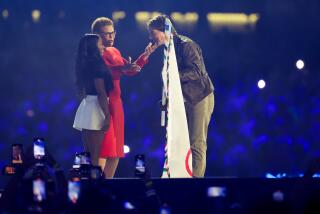An Opening With Appeal
- Share via
NAGANO, Japan — Laboring and hobbling on an artificial right leg, hoisting the Olympic torch in his left hand because it was the only one available, Chris Moon slowly made his way into Minami Nagano Sports Park.
He strained but did not stumble, jogging awkwardly but relentlessly, pressing onward without the right leg and the right hand he lost in a land-mine explosion in 1995.
With the same lurching gait, Moon, a 35-year-old Englishman, completed the 1996 London Marathon in 5 hours 39 minutes. His final steps here took him inside the stadium for the opening ceremony of the XVIII Olympic Winter Games.
When he passed the torch to Takanori Kono, a Japanese gold medalist in nordic combined skiing in 1992, it was not as a novelty, but one athlete handing off to another.
Moon’s appearance was the emotional climax to a ceremony built around a theme of peace, echoed in the words of International Olympic Committee President Juan Antonio Samaranch.
“These 18th Olympic Winter Games are being celebrated in the year of the 50th anniversary of the Universal Declaration of Human Rights,” Samaranch told the parka-clad crowd.
“It is therefore our hope that the appeal of the 185 member states of the United Nations to observe the Olympic truce will foster international dialogue and diplomatic solutions to all conflicts, in an effort to bring human tragedies to an end.”
Samaranch was alluding to the dispute between the United States and Iraq and reports of the United States undertaking military action if negotiations over on-site arms inspection in Iraq break down.
Samaranch has been fervent in his request that the United States abide by the Olympic truce, a tradition dating to the Games of antiquity in which hostilities between nations are to cease during Olympic Games.
Nagano has christened these Games “a festival of peace and friendship,” a theme that dominated a solemn two-hour ceremony here Saturday.
Olympic opening ceremonies, for better or worse, tend to reveal the true nature of the host.
Barcelona’s was flamboyant, culminated by a spectacular lighting of the Olympic caldron by an archer’s flaming arrow. Albertville’s was a pure slice of French avant-garde, eccentric and idiosyncratic. Lillehammer’s was playful and lyrical. Atlanta’s was, well, Atlanta--replete with choreographed Chevy trucks, country-western singers and an ode to “extreme sport” enthusiasts.
There were no rumbling pickups or shredding skateboarders on the grounds at Nagano’s opening ceremony. But there were sumo wrestlers and small Yukinko--”snow children”--dressed in the straw rain gear of ancient Japanese farmers, and there was Midori Ito, the former figure skating world champion, lighting the Olympic caldron while wearing traditional Japanese ceremonial gown and headdress.
It was a reserved, restrained and graceful ceremony, beginning with the simple gong of the bell at the nearby Zenkoji Temple, considered the religious and cultural center of Japan. Such a gong, according to tradition, is supposed to purge humans of their earthly desires and purify their souls.
Moments later, champion sumo wrestler Akebono was summoned to drive away evil spirits by stomping theatrically and menacingly at the center of the stadium, an exercise known as shiko.
The ritual was Japanese, but the performer was American. Akebono was born in Hawaii; his given name is Chad Rowan. With a record of 498-189, he is the first foreign-born grand champion, or yokozuna, of sumo wrestling.
Akebono was clad only from the waist down in his ceremonial wrestling silk. At 6 feet 8 and 516 pounds, that’s a lot of gooseflesh, but Akebono claimed not to mind.
“Ten minutes of cold, a lifetime of memory,” he said afterward.
The purification theme continued with a 1,200-year-old tradition involving the raising of eight two-ton “sacred” wooden pillars, known as onbashira, at north, south, east and west points of the stadium.
The purpose, according to ancient belief, is to purify a plot of land from the temporal world and create a gate through which gods can travel between heaven and earth.
Or, in 1998 context, the Austrian skiers, the Canadian hockey players and the American figure skaters.
Speedskater Eric Flaim, competing in his fourth Winter Olympics after winning silver medals in both long-track and short-track events, carried the flag for the U.S. contingent, predictably dressed in navy felt cowboy hats and knee-length dark-blue parkas.
CBS wired figure skater Tara Lipinski for sound, to questionable results. Frantically waving a tiny American flag, Lipinski was heard to squeal, “U-S-A!” and “Oh, it’s so exciting, I’m so glad I’m here!”
Ito was not a surprise choice to light the caldron; Nagano organizers had announced the selection days earlier. But she was a popular choice. The first woman figure skater to successfully land a triple axel in competition and Japan’s first female world champion, Ito entered the 1992 Winter Games the gold medal favorite. She botched her short program, however, and was forced to settle for a silver medal, but her tearful apology to everyone in Japan endeared her as an Olympic icon in her homeland.
Ito was in tears again Saturday after two giant Japanese-style fans opened to reveal her as she was lifted to the rim of the caldron. Soon, the Olympic flame was aglow and the Nagano Games had officially begun.
“The ceremony really gave me a warm feeling,” volunteer Yumiko Sakei said. “It wasn’t cold at all.”
More to Read
Go beyond the scoreboard
Get the latest on L.A.'s teams in the daily Sports Report newsletter.
You may occasionally receive promotional content from the Los Angeles Times.






